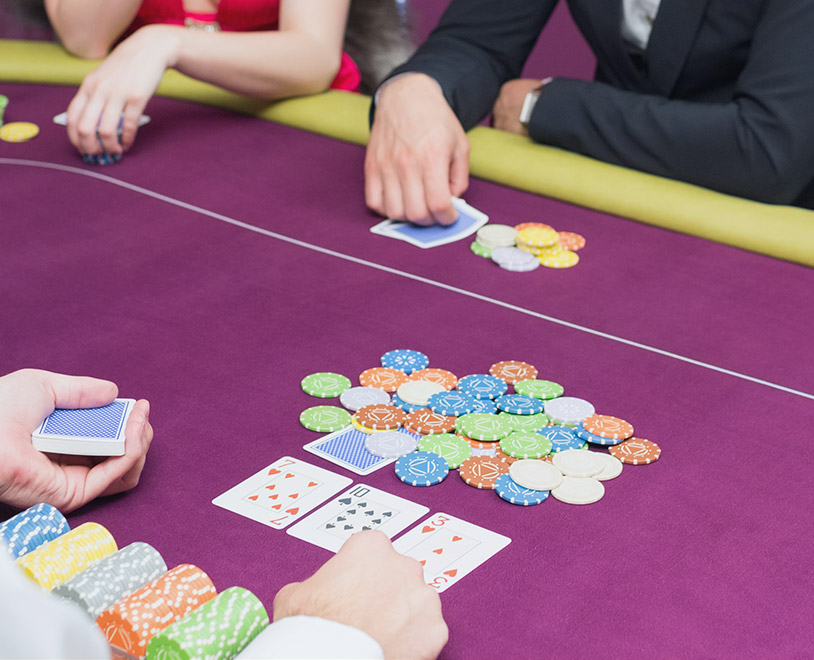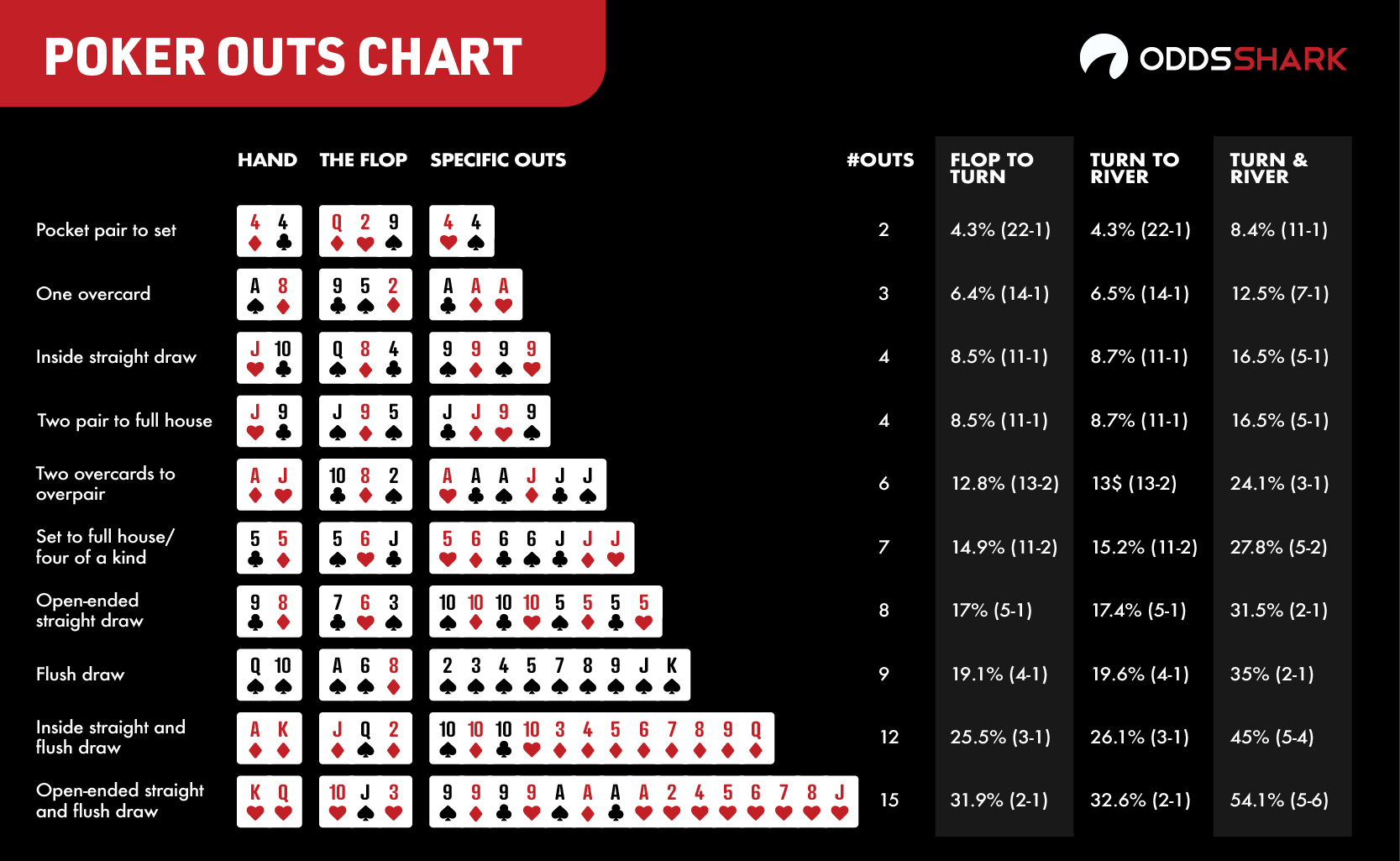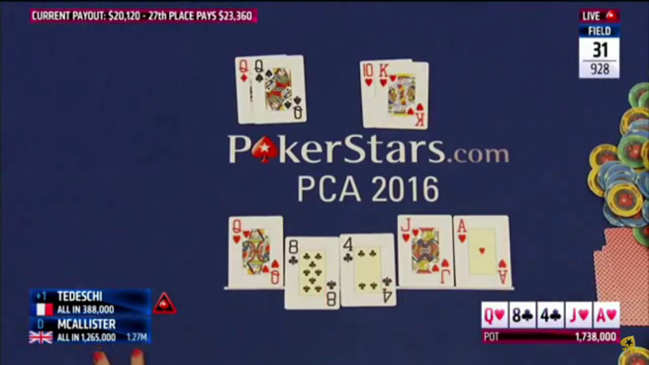Poker Odds Flush Draw After Flop
You already know 5 cards after the flop: your two starting cards and the three flop cards. Any of the remaining 47 unknown cards can still be dealt (52 cards are in a deck in total). 8 of these 47 cards help you to complete your draw, while the other 39 (47-8=39) cards would not complete your draw and are therefore unhelpful. You can call moderate flop bets with strong draws like flush draws and OESDs and can usually just fold weak draws (like gutshots). Don't chase draws! If you have a flush draw on the turn, you will complete your flush on the river less than 20% of the time. You're wasting money when you call big bets on the turn.
- In example 4, the pot odds are 5:1 and the chance of completing his hand are 4.22:1. The pot odds are greater than the odds of completing his flush, so he should call. We could have avoided this scenario by changing the pot odds in our favor. Example 5: If there is $400 in the pot and player we bet $300 (75% of the pot), the pot will grow to $700.
- If you flop a flush draw and a pair also flops, you usually should continue to play. When a pair flops, there is an increased chance that you will run into a full house if you make your flush. Even so, the odds against making your flush with two cards to come are only 2-to-1, and a typical pot offers much more than this.
- General Guidelines
- Seven Card Stud
- Limit Texas Hold'em
As we mentioned earlier, your starting hand decision in Texas hold ’em, though very important, is not the dominating factor that it is in seven-card stud. To be a winner at hold ’em, you must play well not only before the flop, but also on the flop and beyond. If your play on the later streets is poor, the best you can hope for is to break even. Following are a few tips that will help you make the correct decisions for play after the flop, which in turn will largely determine your overall success in this complex game.
Bet most of your draws.
Suppose you have two suited cards and two more of your suit flop, giving you a flush draw. You usually should bet this hand. (If you don’t bet, you almost always should call.) Even though your flush draw currently has no value, betting gives you two ways to win the pot. First, everyone might fold immediately, and second, the flush card might come and you will win anyway.If you don’t improve on the flop, be willing to abandon your hand.
Suppose you are dealt the
Even though this is a good starting hand, there is no guarantee that it will be worth much once the flop comes. If that is the case, you should abandon it immediately. Failure to do so can prove quite costly.
It’s sometimes necessary to throw away a big pair.
When you hold a big pair, you often don’t need to improve your hand to win. But sometimes the flop will be so detrimental that you should fold. For example, suppose you hold the
in a seven-handed pot, the flop comes the
and there is a bet, a raise, and three callers. Under these circumstances, you should throw your hand away, as there are too many ways that you are beat.
In multiway pots, be aware that you might be drawing dead.
Suppose the flop is the
and you hold the
Even though you are trying to make a straight, which is often a very strong hand, you may already be beat by a player who has either jack-seven or queen-jack for a higher straight. In addition, if a jack hits the board, anyone holding a queen will beat you. Clearly, you should throw your hand away in this spot if you are against several opponents.

Discard small pairs when they miss the flop.
Remember, when you play a small pair, you generally must improve to three of a kind. If you don’t improve, your hand has little value and usually should be mucked. As emphasized earlier, the odds against making trips on the flop are almost 8-to-1. And if you miss, the odds of making it on the fourth card are 22-to-1.
If you flop a flush draw and a pair also flops, you usually should continue to play.
When a pair flops, there is an increased chance that you will run into a full house if you make your flush. Even so, the odds against making your flush with two cards to come are only 2-to-1, and a typical pot offers much more than this.
Poker Strategy and Other Topics - November 2019
by Carlos Welch
by Robert Samuels
by Kevin Haney

by Kevin Haney
by Ben Saxton
by Bryan Clark
by Felipe Garcia, CFA and Aaron Byrd, CFA
by Nick Willett
by Mason Malmuth
It is a common misconception that flush is more likely to hit. If you also believe that to be the case, then you are wrong. Well, maybe you are right, but it depends on which perspective you look at it. Let me explain.
As long as you start counting the hand from preflop, then you will hit the straight more often than flush. But if you have a flush draw on flop or turn, then you will hit a flush more often compared to when you have an open-ended straight draw, and you hit a straight.
There is a reason why flush has a higher ranking in poker than straight. It will hit less often. Look at this chance to win a straight and to hit a flush – from Wikipedia.
You will hit a flush every 0.20% of the time. So once every 509 hands. While you will hit a straight about 0.40% of the time or once every 255 hands, so you will hit almost 2 straights for every 1 flush that you hit.Table of ContentsWhy is it easier to make a flush than astraight?
But after all that I have written, why is it easier to hit a flush than a straight?
Well postflop, if you hold a flush draw, you have more outs to hit the draw than holding the open-ended straight draw and hitting the straight. You will have 9 outs to hit a flush on the flop or turn if you have a flush draw.
From flop to the river, we have 9 outs twice to hit a flush, which is roughly 38%, from turn to the river we have about 18% (9 outs once). On the other hand, if you hold an open-ended straight draw, you will have only 8 outs to hit it.
What many people are forgetting is that you will get the flush draw less often than you will open-ended straight draw. Getting a suited hand preflop doesn’t happen super often. You will have a flush draw on the flop only 5.1% of the time.
One thing that is often neglected is you not accounting in the times when you have a gutshot, and you hit it. It seems it doesn’t happen often, but you will usually have 4 outs to hit a straight, which is around 16% from flop to river. Not something we should forget about. On top of that, there are also some double gutters, which also gives you 8 outs to hit your straight.
So only looking from the postflop perspective, it can feel that it is easier to hit a flush than a straight, but as I explained, that can often be misleading. Straight will happen more often.
Let’s say you usually play connectors and therefore your chances to hit your straight draw increase. You would have flopped 8 outs straight draw (either open-ended or a double gutter straight draw) about 10.5% of the time on the flop.How often will an opponent flop a flush draw?
A player will have a flush draw on the flop about 5.1% of the time strictly math speaking and accounting in all the hands. But we know that players don’t play every single hand, and they are more likely to fold more off suited hand than suited hands preflop.
All this makes an opponent hit a flush draw roughly 10% of the time on the flop.Which makes more money: Flush vs. straight?
As expected, flush will make you more money. In my case, not double the amount, but you will make more money with it. Why not the double, you might wonder? Well, if you have a straight, usually you will be willing to stack off with top straight or second nut straight sometimes 3rd nut straight. But when it comes to flush, you will lose quite some money even if you hold a low flush, and it can be less than 3rd nuts. On top of that, not many players will be willing to stack off with the top two or a set on a possible flush board, while the same players don’t have a problem committing with the same hands on possible straight board.
All this reduces your winrate by a little. But you, as you can see from my graph, will still make substantially more profit with a flush compared to straight. They are both great hands; it is just that a flush is stronger.
Now your winrate will, of course, differ a bit. If you have nut flush yo will win more than my 2,000bb/100 hands. If you have a lower flush, then it will be lower. Now sometimes higher flushes will beat us. A scenario of when we hit a flush, and our opponent also hits a flush is not that uncommon, and if you multi table, it will happen on semi-frequent occasions.
The same goes for a straight. Nut straight will give you the most money of any straight. You will still make decent money with 2nd nut straight, just less.
Scenarios, where we hit backdoor straight, will be nicely profitable since it will be harder for an opponent to put us on a straight, as there was no apparent straight draw present when we started betting on the flop. If you want to read more about straight backdoor draws, I have this article I have for you.
What are the odds of getting straight flush?
Odds of hitting a straight flush is so low that it almost doesn’t make sense to write it in percentages. It is a 0.00139% chance you will hit a straight flush. This is 72,192:1 odds against hitting it. SO only once every 72,000 hands you will hit the second most powerful hand in poker.
What are the odds of getting a royal flush?
Poker Odds Flush Draw After Flop Chart
Hitting a royal flush is even harder than a straight flush. The royal flush is the strongest hand you can get in poker. Your chances of hitting it are 0.000154% of the time, or once every650,000 hands (odds against of 649,740:1 to be precise).

I have been dealt quite many royal flushes in my poker career, and frankly, hitting one doesn’t feel special anymore. But I remember that when I hit it for the first time, I was ecstatic for some time. That is how rare the royal flush is.
Does a straight beat a flush?
Poker hand rankings go from strongest to weakest:
- Royal flush
- Straight flush
- Four of a kind
- Full house
- Flush
- Straight
- Three of a kind
- Two pair
- One pair
- No pair (high card)
You can see that straight doesn’t beat a flush, but it does beat many other hands, making it a powerful hand on right boards. When the board is not paired, and no flush can be present, then if you hold the highest straight, you will have the best hand.
What are the odds of getting pocket aces?
Chances of being dealt pocket aces are slightly less than 0.5%. Exactly once every 221 hands, you will get the rockets. The number of players on the table doesn’t matter. There are still 52 cards in the deck, no matter how many players are at the table.
Poker Odds Flush Draw After Flop Game
If you wonder how often you can expect to win with AA depending on the number of opponents and different hands you are up against, then read this post.
What are the odds of an ace flop?
We all know it, that horrible feeling when you hope ace doesn’t show up on the flop, but it seems like it always does. It doesn’t always come. But you will see ace on the flop 42% of the time, which is quite often. But don’t worry on some occasions you will also hit two flushes, sets or straights yourself. That is why pocket kings have around 70% (and not only 58%) to win against Ax.